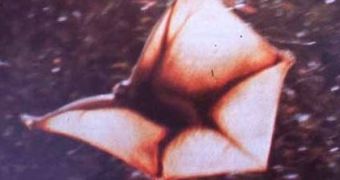The flying lemurs of southeastern Asia are the best gliders amongst mammals. They have a patagium (skin membrane like in the bat's wings) that is as large as geometrically possible and can glide as far as 70 m (235 ft) with minimal loss of height, and the maximal glides can be 130 m (433 ft) long, as much as two stadiums. Flying lemurs can execute 90-degree turns while gliding, to land gently on a tree trunk.
The patagium goes from the shoulder blades to the fore-paw, from the tip of the rear-most finger to the tiptoes, and from the hind legs to the tip of the tail; unlike in other known gliding mammals (like flying squirrels), even the spaces between the fingers and toes are webbed to increase the total surface area, as in the wings of bats.
Now a team of scientists from Singapore, United Kingdom and University of California, Berkeley, has investigated the sophisticated gliding of these animals using miniature accelerometers, using motion-detecting technology similar to that employed in Wii remote controllers.
The study, published in the Proceedings of the Royal Society B journal, explains us biomechanics issues of gliding animals ranging from frogs, lizards and snakes, to squirrels and marsupials, but it could also improve the technology of flexible winged aircraft like hang gliders and micro air vehicles.
The fully spread patagium of the flying lemurs or colugos reaches the size of a large doormat.
"This makes them quite maneuverable," said first author Greg Byrnes, a graduate student in UC Berkeley's Department of Integrative Biology.
"I have observed colugos gliding toward one tree and, seemingly changing their minds in midair, dodge around it and land on a different tree. I've seen animals gliding and get to a place where foliage is dense, and they will actually collapse their membrane, haul through the leaves and then open up and glide some more. Obstacles are not much of an issue for them," said Byrnes.
But the animal is nocturnal, timid and well camouflaged by the pattern of its coat, so the species is hard to investigate, even if common in city parks, like in Singapore. The team wanted to see the forces exerted by the animal during take-off and landing, and their variation with the gliding distance. Accelerometers measures both force and speed and the latest technology made them small (half of a gum stick) and cheap enough to be placed on the back of a colugo (but not on a flying squirrel).
The investigation was made on colugos captured in Singapore forests, tagged with accelerometers and freed. The accelerometers fell off and could be retrieved, as a radio tag on the backpack continuously tracked their location.
The data showed that colugos push off from trees more powerfully for long jumps, but terminal velocity was reached as soon as the patagium was spread, and the landing force was the same, no matter the length of the glide.
"The landing forces increase with distance only for short leaps, a few times their body length of 75 cm (30 in), probably because they land with two limbs instead of four. Once all four limbs are spread out, however, the colugo may even get enough lift to land more softly the farther it travels. This fits with aerodynamic models," said Byrnes.
"The colugo's ability to change its posture for aerial braking just prior to landing is probably an important trait in the transition from leaping to gliding. It enables the gliders to reduce the impact forces in long glides, thus reducing the risk of injury," wrote the authors.

 14 DAY TRIAL //
14 DAY TRIAL //